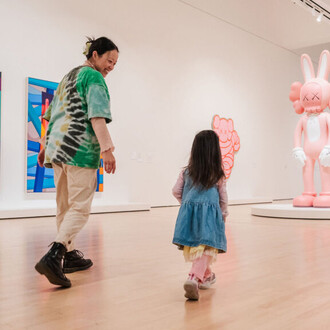Max Ernst was surely the most famous artist in any field to sire a member of the American Academy and Institute of Arts and Letters. To reverse that equation: Jimmy Ernst is the only son of a great artist, that I can think of anyway, who reached for greatness in the selfsame art.
(Kurt Vonnegut, A tribute to Jimmy Ernst, 1984)
Weinstein Gallery is pleased to present Max and Jimmy Ernst: Father son of surrealism. Featuring thirty paintings and works on paper created between 1925 and 1984, this unique exhibition uses the works of this renowned father and son as a lens to examine the rich cultural exchange between the European émigrés and the American art scene during and after World War II.
Max Ernst, a pioneer of Dadaism and Surrealism, was born in Germany in 1891 and became one of the most influential artists of the 20th century. His innovative techniques, such as frottage and grattage, and his exploration of the unconscious mind through dreamlike imagery positioned him at the forefront of the Surrealist movement in Paris. Labeled as a "degenerate" by the Nazi regime, he fled to France and later to the United States. In his exile, he discovered the Native Americans and the American Southwest. Here, he saw the "landscapes and images he had been painting long before he came to the United States", as described by Jimmy Ernst. He was so moved by this unique landscape that he built a home with his fourth wife, Dorothea Tanning, in Sedona in 1946 and lived there until 1956, when he sold the property to Jimmy. Max also discovered the Hopi kachina doll, the katsinman representation of the Hopi spirit, and began an impressive collection. He understood and admired the synergy between the Hopi and the Surrealists, who didn't differentiate between waking life and dreaming life.
Jimmy Ernst was born in 1920, the son of Max and Luise Straus-Ernst, a well-known art historian and journalist. His childhood was marked by his parent's separation and the rise of antisemitism in Germany. In 1938, at the age of 18, Jimmy emigrated to the United States. He found work in the mailroom of the Museum of Modern Art in New York and developed close friendships with many of the young American artists experimenting with abstraction. While initially distant from his father's Surrealist circle and often critical of the movement, Jimmy forged his own artistic identity, drawing upon his deep interest in science, jazz, and Native American culture. Jimmy would become one of the most significant members of the New York School. His paintings would be included in over eighty permanent museum collections during his lifetime, including the Museum of Modern Art, NY, the Solomon R. Guggenheim Museum, and the Whitney Museum of American Art.
The relationship between Max and Jimmy was complex and shaped by turbulent historical times and the personal challenges each faced. While Max remained a towering figure in Surrealism, Jimmy's work reflected a synthesis of this influence with distinctly American elements, helping to shape the burgeoning Abstract Expressionist movement. Both immigrants to the United States, their art reflects a dialogue not only between father and son but also between the Old World and the New, between the European avant-garde and the American frontier. This exhibition offers a rare opportunity to see their works side by side, revealing the interplay of influence and innovation that shaped their respective careers and the broader narrative of 20th-century art.
















